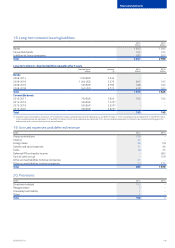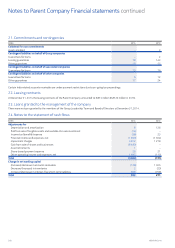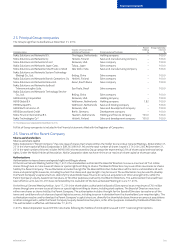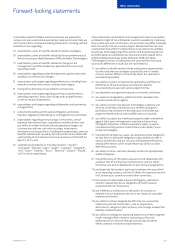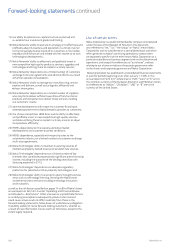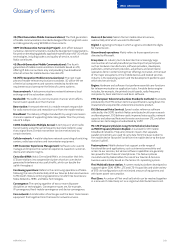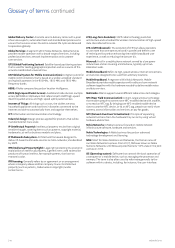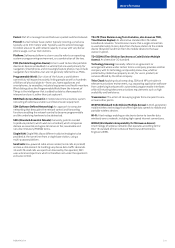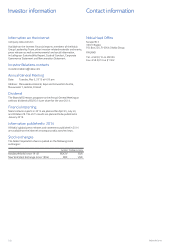Nokia 2014 Annual Report Download - page 211
Download and view the complete annual report
Please find page 211 of the 2014 Nokia annual report below. You can navigate through the pages in the report by either clicking on the pages listed below, or by using the keyword search tool below to find specific information within the annual report.
209
Other information
NOKIA IN 2014
Glossary of terms
3G (Third Generation Mobile Communications): The third generation
of mobile communications standards designed for carrying both voice
and data generally using WCDMA or close variants.
3GPP (3rd Generation Partnership Project): Joint eort between
numerous telecommunications standards development organizations,
focused on developing globally applicable specications for 3G cellular
technologies, including codecs and quality of service, to which
Nokia contributes.
4G (Fourth Generation Mobile Communications): The fourth
generation of mobile communications standards based on LTE,
oering IP data connections only and providing true broadband
internet access for mobile devices. See also LTE.
5G (Fifth Generation Mobile Communications): The next major
phase of mobile telecommunications standards. 5G will be the set
of technical components and systems needed to handle new
requirements and overcome the limits of current systems.
Access network: A telecommunications network between a local
exchange and the subscriber station.
Bandwidth: The width of a communication channel, which aects
transmission speeds over that channel.
Base station: A network element in a mobile network responsible
for radio transmission and reception to or from the mobile station.
Broadband: The delivery of higher bandwidth by using transmission
channels capable of supporting data rates greater than the primary
rate of 9.6 Kbps.
CDMA (Code Division Multiple Access): A technique in which radio
transmissions using the same frequency band are coded in a way
that a signal from a certain transmitter can be received only by
certain receivers.
Cellular network: A mobile telephone network consisting of switching
centers, radio base stations and transmission equipment.
CEM (Customer Experience Management): Software suite used to
manage and improve the customer experience, based on customer,
device and network insights.
Centralized RAN: Nokia Centralized RAN is an innovation that links
LTE base stations into cooperative clusters that turn user device
generated interference into useful trac, which can double the
uplink throughput.
Continuing operations: Refers to the continuing operations of Nokia
following the sale of substantially all of our Devices & Services business
to Microsoft. Nokia’s continuing operations include three businesses:
Nokia Networks, HERE, and Nokia Technologies.
Convergence: The coming together of two or more disparate
disciplines or technologies. Convergence types are, for example,
IP convergence, xed-mobile convergence and device convergence.
Core network: A combination of exchanges and the basic transmission
equipment that together form the basis for network services.
Devices & Services: Nokia’s former mobile device business,
substantially all of which was sold to Microsoft.
Digital: A signaling technique in which a signal is encoded into digits
for transmission.
Discontinued operations: Mainly refers to those operations we
divested to Microsoft.
Ecosystem: An industry term to describe the increasingly large
communities of mutually benecial partnerships that participants
such as hardware manufacturers, software providers, developers,
publishers, entertainment providers, advertisers and ecommerce
specialists form in order to bring their oerings to market. At the heart
of the major ecosystems in the mobile devices and related services
industry is the operating system and the development platform upon
which services are built.
Engine: Hardware and software that perform essential core functions
for telecommunication or application tasks. A mobile device engine
includes, for example, the printed circuit boards, radio frequency
components, basic electronics and basic software.
ETSI (European Telecommunications Standards Institute): Standards
produced by the ETSI contain technical specications laying down the
characteristics required for a telecommunications product.
EVS (Enhanced Voice Service): Speech codec reference software
selected by the 3GPP, to which Nokia contributed multi-year research
and development. EVS delivers vastly improved voice quality, network
capacity and advanced features for voice services over LTE, and other
radio access technologies standardized by 3GPP.
FD-LTE (Frequency Division Long-Term Evolution) also known
as FDD (Frequency Division Duplex): A standard for LTE mobile
broadband networks. Frequency Division means that separate,
parallel connections are used to carry data from the base station to
the mobile device (‘downlink’) and from the mobile device to the base
station (‘uplink’).
Feature phone: Mobile devices that support a wide range of
functionalities and applications, such as internet connectivity and
access to our services, but whose software capabilities are generally
less powerful than those of smartphones. The feature phones
manufactured by Nokia before the sale of our Devices & Services
business were mostly based on the Series 30+ operating system.
Flexi Multiradio base station: A system module platform developed to
support higher GSM, HSPA+, LTE and LTE-A capacities and wider variety
of BTS site congurations with minimized amount of equipment and
with lower power consumption.
Flexi Zone: A number of Flexi small cells which can be meshed together
in a zone which collectively act as a single but distributed macro cell.


